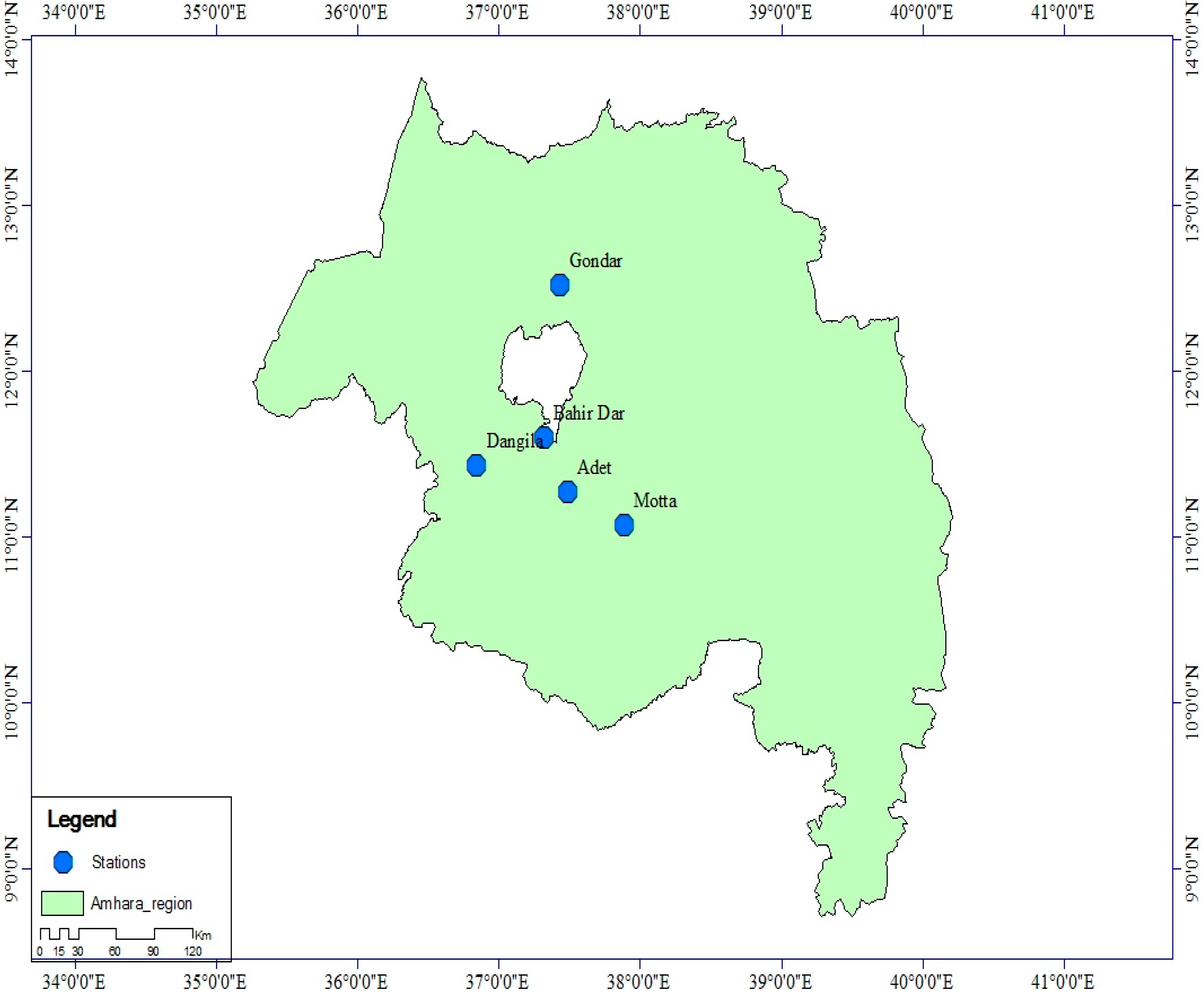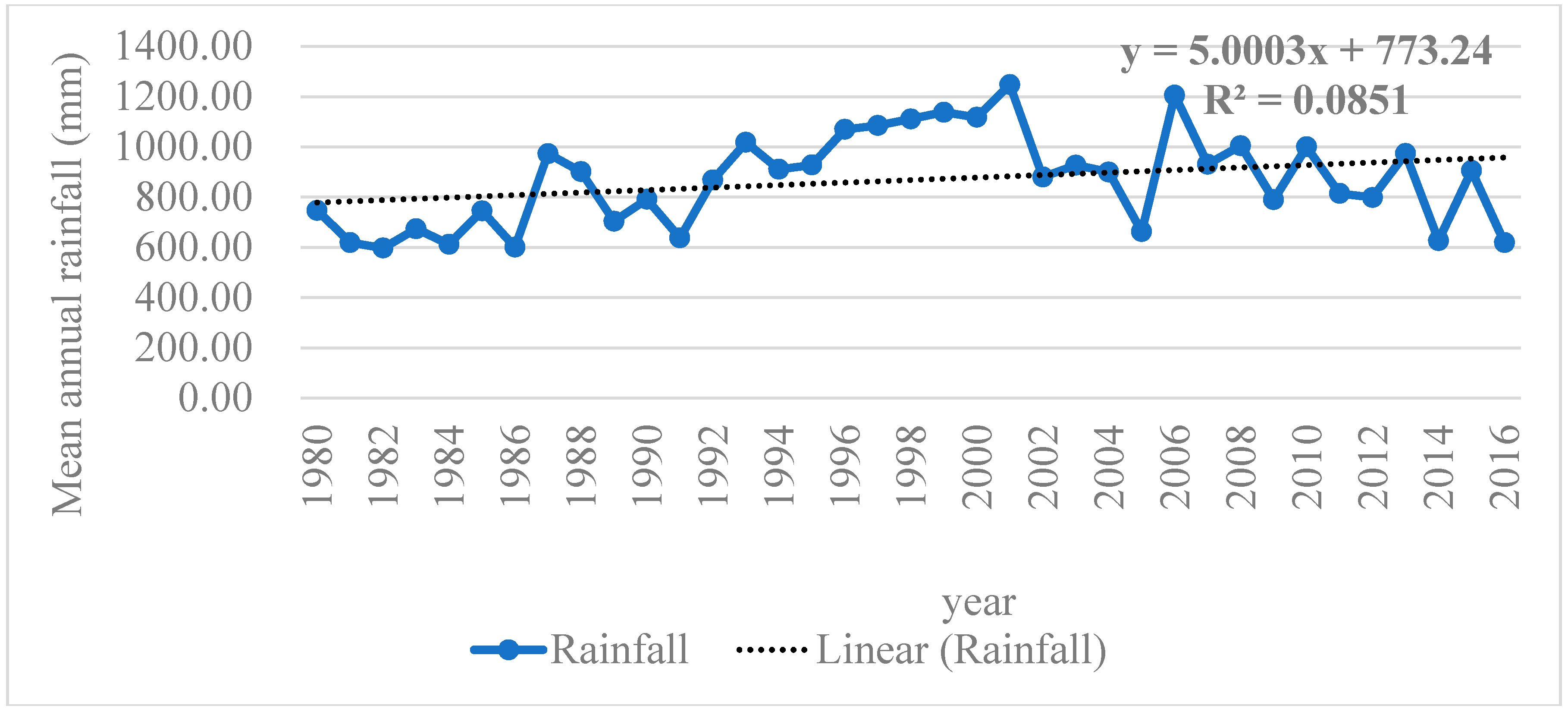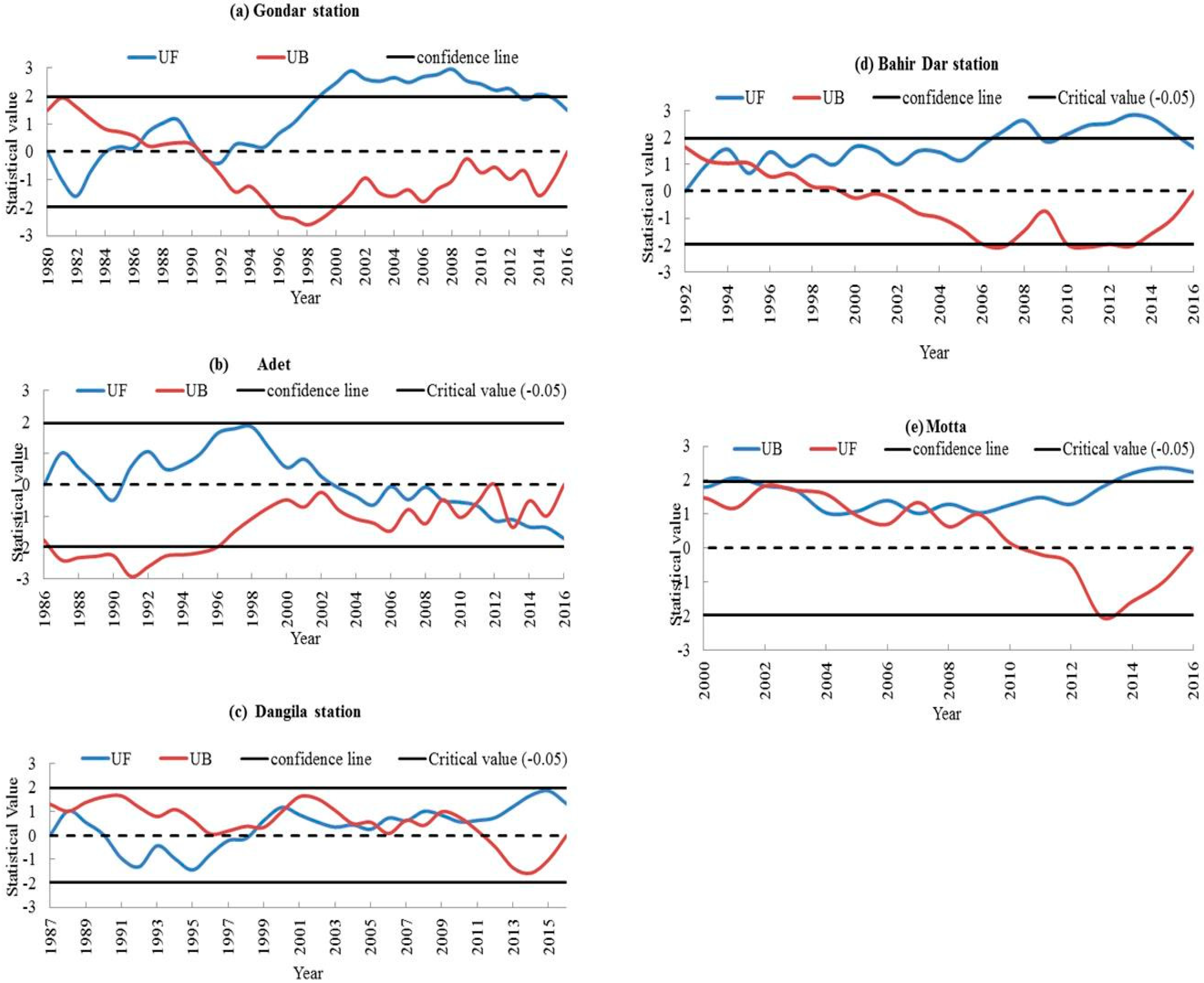Innovative Trend Analysis of Annual and Seasonal Rainfall Variability in Amhara Regional State, Ethiopia
Abstract
:1. Introduction
2. Materials and Methods
2.1. Study Area
2.2. Data Sources
2.3. Methods
2.3.1. Mann–Kendall Trend Test
2.3.2. Innovative Trend Analysis Method (ITAM)
2.3.3. Sen’s Slope Estimator Test
3. Results
3.1. Analysis of Annual Rainfall
3.2. Monthly and Seasonal Variability of Rainfall
3.3. Seasonal and Annual Rainfall Trends
3.4. Comparison of the Trend Results
4. Discussion
5. Conclusions
Author Contributions
Funding
Acknowledgments
Conflicts of Interest
References
- Yang, P.; Xia, J.; Zhang, Y.; Hong, S. Temporal and spatial variations of precipitation in Northwest China during 1960–2013. Atmos. Res. 2017, 183, 283–295. [Google Scholar] [CrossRef]
- Burgess, C.P.; Taylor, M.A.; Stephenson, T.; Mandal, A. Frequency analysis, infilling and trends for extreme precipitation for Jamaica (1895–2100). J. Hydrol. Reg. Stud. 2015, 3, 424–443. [Google Scholar] [CrossRef]
- Chatterjee, S.; Khan, A.; Akbari, H.; Wang, Y. Monotonic trends in spatio-temporal distribution and concentration of monsoon precipitation (1901–2002), West Bengal, India. Atmos. Res. 2016, 182, 54–75. [Google Scholar] [CrossRef]
- Panthi, J.; Dahal, P.; Shrestha, M.L.; Aryal, S.; Krakauer, N.Y.; Pradhanang, S.M.; Lakhankar, T.; Jha, A.K.; Sharma, M.; Karki, R. Spatial and Temporal Variability of Rainfall in the Gandaki River Basin of Nepal Himalaya. Climate 2015, 3, 210–226. [Google Scholar] [CrossRef] [Green Version]
- Li, J.; Zhu, Z.; Dong, W. A new mean-extreme vector for the trends of temperature and precipitation over China during 1960–2013. Meteorol. Atmos. Phys. 2016, 129, 273–282. [Google Scholar] [CrossRef]
- Toride, K.; Cawthorne, D.L.; Ishida, K.; Kavvas, M.L.; Anderson, M.L. Science of the Total Environment Long-term trend analysis on total and extreme precipitation over Shasta Dam watershed. Sci. Total Environ. 2018, 626, 244–254. [Google Scholar] [CrossRef] [PubMed]
- Li, J.; Zhu, Z.; Dong, W. Assessing the uncertainty of CESM-LE in simulating the trends of mean and extreme temperature and precipitation over China. Int. J. Climatol. 2017, 37, 2101–2110. [Google Scholar] [CrossRef]
- Adugna, B.T.; Goshu, G. Integrating aquaculture with traditional farming system: Socioeconomic assessment in the Amhara region, Ethiopia. Ecohydrol. Hydrobiol. 2010, 10, 223–230. [Google Scholar] [CrossRef]
- Girma, E.; Tino, J.; Wayessa, G. Rainfall trend and variability analysis in Setema-Gatira area of Jimma, Southwestern Ethiopia. Afr. J. Agric. Res. 2016, 11, 3037–3045. [Google Scholar] [CrossRef]
- Wagesho, N.; Goel, N.K.; Jain, M.K. Investigation of non-stationarity in hydro-climatic variables at Rift Valley lakes basin of Ethiopia. J. Hydrol. 2012, 444–445, 113–133. [Google Scholar] [CrossRef]
- Liao, W.; Wang, X.; Fan, Q.; Zhou, S.; Chang, M.; Wang, Z.; Wang, Y.; Tu, Q. Long-term atmospheric visibility, sunshine duration and precipitation trends in South China. Atmos. Environ. 2015, 107, 204–216. [Google Scholar] [CrossRef]
- Xu, M.; Kang, S.; Wu, H.; Yuan, X. Detection of spatio-temporal variability of air temperature and precipitation based on long-term meteorological station observations over Tianshan Mountains, Central Asia. Atmos. Res. 2018, 203, 141–163. [Google Scholar] [CrossRef]
- Lappas, I.; Tsioumas, V.; Zorapas, V. Spatial—Temporal Analysis, Variation and Distribution of Precipitation in the Water District of Central—Eastern Greece. Bull. Geol. Soc. Greece 2013, XLVII, 740–749. [Google Scholar] [CrossRef]
- Hamisi, J. Study of Rainfall Trends and Variability Over Tanzania a Research Project Submitted in Partial Fulfilment of the Requirements for the Postgraduate Diploma in Meteorology. Ph.D. Thesis, University of Nairobi, Nairobi, Kenya, August 2013. [Google Scholar]
- Feizi, V.; Mollashahi, M.; Frajzadeh, M.; Azizi, G. Spatial and Temporal Trend Analysis of Temperature and Precipitation in Iran. Ecopersia 2015, 2, 727–742. [Google Scholar]
- Jakob, D.; Walland, D. Variability and long-term change in Australian temperature and precipitation extremes. Weather Clim. Extrem. 2016, 14, 36–55. [Google Scholar] [CrossRef]
- Duhan, D.; Pandey, A. Statistical analysis of long term spatial and temporal trends of precipitation during 1901–2002 at Madhya Pradesh, India. Atmos. Res. 2013, 122, 136–149. [Google Scholar] [CrossRef]
- Sharma, C.S.; Panda, S.N.; Pradhan, R.P.; Singh, A.; Kawamura, A. Precipitation and Temperature Changes in Eastern India by Multiple Trend Detection Methods. Atmos. Res. 2016, 180, 211–225. [Google Scholar] [CrossRef]
- Diop, L.; Bodian, A. Spatiotemporal Trend Analysis of the Mean Annual Rainfall in Senegal. Eur. Sci. J. 2016, 12, 231–245. [Google Scholar]
- Sarricolea, P.; Martín-Vide, J. Spatial analysis of rainfall daily trends and concentration in Chile Análisis espacial de las precipitaciones diarias y sus tendencias de concentración en Chile. Investig. Geogr. 2014, 53–66. [Google Scholar] [CrossRef]
- Toggweiler, J.; Key, R. Ocean circulation: Thermohaline circulation. Encycl. Atmos. Sci. 2001, 4, 1549–1555. [Google Scholar]
- Wang, Z.; Luo, Y.; Liu, C.; Xia, J.; Zhang, M. Spatial and temporal variations of precipitation in Haihe River Basin, China: Six decades of measurements. Hydrol. Process. 2011, 25, 2916–2923. [Google Scholar] [CrossRef]
- Sahu, R.K.; Khare, D. Spatial and temporal analysis of rainfall trend for 30 districts of a coastal State (Odisha) of India. Int. J. Geol. Earth Environ. Sci. 2015, 5, 40–53. [Google Scholar]
- Caloiero, T.; Coscarelli, R.; Mancini, M. Trend detection of annual and seasonal rainfall in Calabria (Southern Italy). Int. J. Climatol. 2011, 31, 44–56. [Google Scholar] [CrossRef]
- Theobald, A.; Mcgowan, H.; Speirs, J. Trends in synoptic circulation and precipitation in the Snowy Mountains region, Australia, in the period 1958–2012. Atmos. Res. 2016, 169, 434–448. [Google Scholar] [CrossRef] [Green Version]
- Yang, F.; Lu, C. Catena Spatiotemporal variation and trends in rainfall erosivity in China’s dryland region during 1961–2012. Catena 2015, 133, 362–372. [Google Scholar] [CrossRef]
- Onyutha, C.; Tabari, H.; Taye, M.T.; Nyandwaro, G.N.; Willems, P. Analyses of rainfall trends in the Nile River Basin. J. Hydro-Environ. Res. 2015, 13, 36–51. [Google Scholar] [CrossRef]
- Gocic, M.; Trajkovic, S. Analysis of changes in meteorological variables using Mann-Kendall and Sen’s slope estimator statistical tests in Serbia. Glob. Planet. Chang. 2013, 100, 172–182. [Google Scholar] [CrossRef]
- Ahmad, I.; Zhang, F.; Tayyab, M.; Anjum, M.N.; Zaman, M.; Liu, J.; Farid, H.U.; Saddique, Q. Spatiotemporal analysis of precipitation variability in annual, seasonal and extreme values over upper Indus River basin. Atmos. Res. 2018, 213, 346–360. [Google Scholar] [CrossRef]
- Asfaw, A.; Simane, B.; Hassen, A.; Bantider, A. Variability and time series trend analysis of rainfall and temperature in northcentral Ethiopia: A case study in Woleka sub-basin. Weather Clim. Extrem. 2017, 19, 29–41. [Google Scholar] [CrossRef]
- Ma, X.; He, Y.; Xu, J.; Van Noordwijk, M.; Lu, X. Catena Spatial and temporal variation in rainfall erosivity in a Himalayan watershed. Catena 2014, 121, 248–259. [Google Scholar] [CrossRef]
- Gu, X.; Zhang, Q.; Singh, V.P.; Shi, P. Changes in magnitude and frequency of heavy precipitation across China and its potential links to summer temperature. J. Hydrol. 2017, 547, 718–731. [Google Scholar] [CrossRef]
- Laurent, J.S.; Mazumder, A. Influence of seasonal and inter-annual hydro-meteorological variability on surface water fecal coliform concentration under varying land-use composition. Water Res. 2013, 48, 170–178. [Google Scholar] [CrossRef] [PubMed]
- Wang, H.; Zhang, M.; Zhu, H.; Dang, X.; Yang, Z.; Yin, L. Hydro-climatic trends in the last 50 years in the lower reach of the Shiyang River Basin, NW China. Catena 2012, 95, 33–41. [Google Scholar] [CrossRef]
- Mbungu, W.; Ntegeka, V.; Kahimba, F.C.; Taye, M.; Willems, P. Temporal and spatial variations in hydro-climatic extremes in the Lake Victoria basin. Phys. Chem. Earth 2012, 50–52, 24–33. [Google Scholar] [CrossRef]
- Tekleab, S.; Mohamed, Y.; Uhlenbrook, S. Hydro-climatic trends in the Abay/Upper Blue Nile basin, Ethiopia. Phys. Chem. Earth 2013, 61–62, 32–42. [Google Scholar] [CrossRef]
- Angassa, A.; Oba, G. Relating long-term rainfall variability to cattle population dynamics in communal rangelands and a government ranch in southern Ethiopia. Agric. Syst. 2007, 94, 715–725. [Google Scholar] [CrossRef]
- Seleshi, Y.; Zanke, U. Recent changes in rainfall and rainy days in Ethiopia. Int. J. Climatol. 2004, 24, 973–983. [Google Scholar] [CrossRef] [Green Version]
- Yenehun, A.; Walraevens, K.; Batelaan, O. Spatial and Temporal Variability of Groundwater Recharge in Geba Basin, Northern Ethiopia. J. Afr. Earth Sci. 2017, 134, 198–212. [Google Scholar] [CrossRef]
- Tsidu, G.M. High-resolution monthly rainfall database for Ethiopia: Homogenization, reconstruction, and gridding. J. Clim. 2012, 25, 8422–8443. [Google Scholar] [CrossRef]



| S/No | Stations | Elevation (m) | Latitude (N) | Longitude (E) | Area (km2) | Annual Mean Precipitation (mm) |
|---|---|---|---|---|---|---|
| 1 | Gondar | 1973 | 37.4319 | 12.5212 | 22,319.11 | 1102.15 |
| 2 | Adet | 2179 | 37.4931 | 11.2745 | 22,914.24 | 515.75 |
| 3 | Bahir Dar | 1827 | 37.322 | 11.6027 | 26,750.85 | 656.75 |
| 4 | Dangila | 2116 | 36.846 | 11.4337 | 17,802.44 | 1276.00 |
| 5 | Motta | 2417 | 37.89 | 11.074 | 16,362.48 | 1142.95 |
| Months | Gondar | Adet | Bahirdar | Dangla | Motta | Rainfall (mm) | Z-Score |
|---|---|---|---|---|---|---|---|
| January | 5.21 | 2.58 | 1.05 | 1.13 | 2.15 | 2.42 | (0.90) |
| February | 14.13 | 2.61 | 0.38 | 1.24 | 2.08 | 4.09 | (0.88) |
| March | 38.52 | 14.62 | 10.81 | 9.07 | 10.82 | 16.77 | (0.72) |
| April | 96.76 | 27.08 | 13.04 | 17.28 | 18.65 | 34.56 | (0.49) |
| May | 193.90 | 70.13 | 44.27 | 67.22 | 30.79 | 81.26 | 0.09 |
| June | 347.19 | 93.30 | 122.39 | 122.71 | 44.93 | 146.10 | 0.91 |
| July | 426.07 | 192.44 | 281.82 | 165.16 | 122.03 | 237.51 | 2.06 |
| August | 283.65 | 159.35 | 212.53 | 167.60 | 119.15 | 188.46 | 1.44 |
| September | 129.95 | 96.72 | 112.33 | 107.66 | 67.48 | 102.83 | 0.37 |
| October | 64.87 | 65.31 | 44.83 | 49.38 | 41.91 | 53.26 | (0.26) |
| November | 21.10 | 14.16 | 5.44 | 14.72 | 12.93 | 13.67 | (0.75) |
| December | 5.70 | 5.76 | 2.70 | 2.18 | 4.27 | 4.12 | (0.87) |
| Kiremt | 352.30 | 148.37 | 205.58 | 151.83 | 286.11 | 228.84 | 571.15 |
| Meher | 71.98 | 58.73 | 54.20 | 57.25 | 40.77 | 56.59 | 168.85 |
| Bega | 8.35 | 3.65 | 1.38 | 1.52 | 2.83 | 3.55 | 9.72 |
| Belg | 109.73 | 37.28 | 22.71 | 31.19 | 20.09 | 44.20 | 131.68 |
| S/No. | Name of Stations | Z (MK) | β | Change (%) | |
|---|---|---|---|---|---|
| 1 | Gondar | 1.69 ** | 0.54 | 1.84 ** | 0.93 |
| 2 | Adet | −0.32 | −0.79 | 3.50 | 2.20 |
| 3 | Bahir Dar | −0.07 * | −23.51 | 1.80 * | 1.36 |
| 4 | Dangla | −0.36 | −0.39 | 1.26 | 1.27 |
| 5 | Motta | 0.93 *** | 1.48 | 0.63 *** | 0.79 |
© 2018 by the authors. Licensee MDPI, Basel, Switzerland. This article is an open access article distributed under the terms and conditions of the Creative Commons Attribution (CC BY) license (http://creativecommons.org/licenses/by/4.0/).
Share and Cite
Gedefaw, M.; Yan, D.; Wang, H.; Qin, T.; Girma, A.; Abiyu, A.; Batsuren, D. Innovative Trend Analysis of Annual and Seasonal Rainfall Variability in Amhara Regional State, Ethiopia. Atmosphere 2018, 9, 326. https://doi.org/10.3390/atmos9090326
Gedefaw M, Yan D, Wang H, Qin T, Girma A, Abiyu A, Batsuren D. Innovative Trend Analysis of Annual and Seasonal Rainfall Variability in Amhara Regional State, Ethiopia. Atmosphere. 2018; 9(9):326. https://doi.org/10.3390/atmos9090326
Chicago/Turabian StyleGedefaw, Mohammed, Denghua Yan, Hao Wang, Tianling Qin, Abel Girma, Asaminew Abiyu, and Dorjsuren Batsuren. 2018. "Innovative Trend Analysis of Annual and Seasonal Rainfall Variability in Amhara Regional State, Ethiopia" Atmosphere 9, no. 9: 326. https://doi.org/10.3390/atmos9090326






